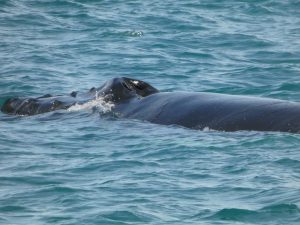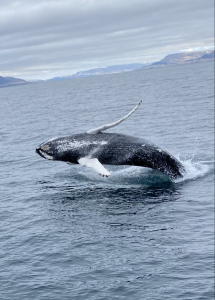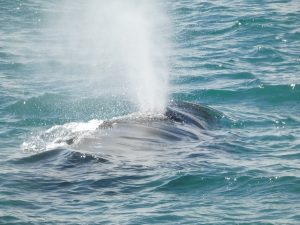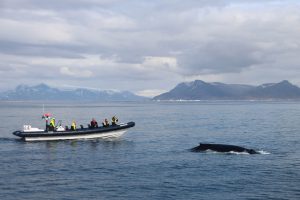The Best Time to See Whales in Iceland
Best time to see whales in Iceland
Are you visiting Iceland and hoping to see some amazing sea mammals: whales, dolphins or porpoises? Then you certainly find yourself visiting the right country, off the coast of Iceland one can find as many as 23 different cetacean species! But some of these are seen more often than others and not all of them are here year-round. This blog is here to help you find out when to expect which species and where you can find them!

Different seasons in Reykjavik
In Reykjavik you can go whale watching year-round. In winter the weather is more unstable, so the chances of cancellation due to rough sea are a bit higher than in summer. But in exchange there are not as many people on board, so you will get an extra nice and relaxed atmosphere on board. As to your chances to see whales, not all species are equally abundant in Iceland year-round. Baleen whales are usually migratory, and most of them will leave Icelandic waters, as they go to warmer waters to breed and give birth. Even though most humpback whales and minke whales leave during winter, some stay behind and are still occasionally seen in the bay of Faxafloí. For example in the winter of 2019, January was an extraordinary month, humpback whales were seen on 90% of all tours going out with Special Tours! So even though on average the chances to see humpback whales and minke whales are smaller in winter, there is still a chance of finding them. The toothed whale species commonly found in the bay of Faxafloí, harbor porpoises and white-beaked dolphins, are non-migratory and the chances of spotting them do not depend much on the season.

Different species around Iceland
Above, the four main species in Faxafloí were mentioned, but there have also been sightings of other whale species in the bay of Faxafloí, like killer whales, sei whales, fin whales, northern bottlenose whales, long-finned pilot whales and even a blue whale. These whale species do enter the bay from time to time, but it is extremely uncommon to see them here and one needs to be rather lucky! However in the past week, killer whales were spotted on two different days, that is amazing!
But if you want to see a killer whale, Olafsvík is the place to be. Killer whales are there in winter feeding on herring, although the best time to see them is between March and June. In Olafsvík you can also spot sperm whales in spring and early summer.
The three largest whales on earth: the blue whale, fin whale and sei whale are all baleen whales and therefore your chances to spot them are highest in summer. However, it is very hard to see fin whales and sei whales everywhere around Iceland. For a blue whale your best bet is in Húsavík, but even there you need to be quite lucky. The toothed whales, narwhals and belugas, are rarely spotted around Iceland. The solution to see a beluga, would be to go to a sanctuary in the Westman islands.
Some species we almost never see, for example the beaked whales. Because they are very deep diving whales they do not spend a lot of time on the surface. It makes it basically impossible to see them and that is also why there is so little known about them. Another very rare species is the northern right whale. This species was last seen in 2018 in the bay of Faxafloí, that was unbelievable! The northern right whale was the right whale to hunt and therefore the numbers are so far down that nowadays it is among the most endangered species worldwide. Therefore you have to be incredibly lucky to meet this whale, but apparently it is not impossible to meet one in the Faxafloí bay.

Time of the day
One might wonder if there is a difference between morning, afternoon and evening tours. Well, whales don´t have a day-night rhythm like we humans do and therefore the time does not influence your chances to see them. Instead, it is the weather conditions that are relevant when you go whale watching. Whales are of course not bothered by rain, wind or sun. But for our human eyes, it is much harder to see them from far away when it is rainy or when the waves are high due to strong winds. Sun can be nice, but its reflection on the water could blind you. So arguably, the most perfect conditions are a flat sea and a cloudy sky. On average the weather tends to be slightly better in the mornings than later on the day, but this is very variable and definitely not always the case. The best solution would be to check the forecast, but even then, that is no guarantee since the Icelandic weather forecast seems to be surprisingly inaccurate.
All in all, if you want to see breaching, tail-slapping, pec-slapping, spy-hopping or fluking humpback whales? Or maybe you are coming for jumping, bow-riding and playful white-beaked dolphins? Or do you hope to spot the beautiful arching backs of minke whales? Or maybe you always wanted to see the smallest cetacean of Iceland: the harbor porpoise? Well, if this is the case, Special Tours in Reykjavik is a perfect choice for you. There you can find the harbor porpoises and white-beaked dolphins year-round. Throughout the year there is always a chance of finding humpback whales and minke whales, although your best chances to see these two are from April to September. We hope to see you soon in the old harbor of Reykjavik, where we can take you out onto the bay of Faxafloí to show you some of those incredible ocean mammals!

– Iris








